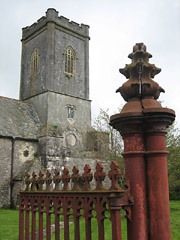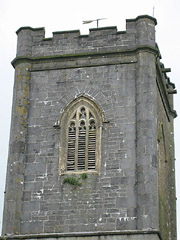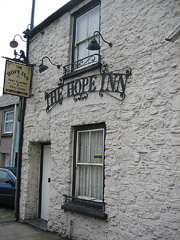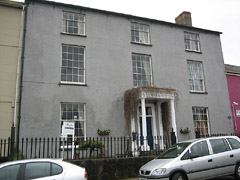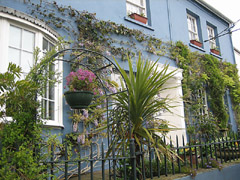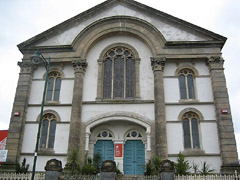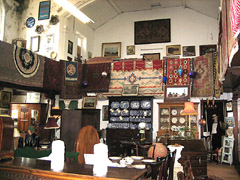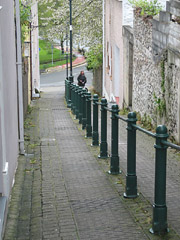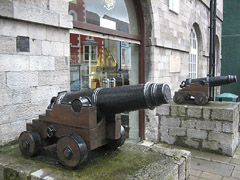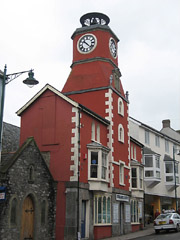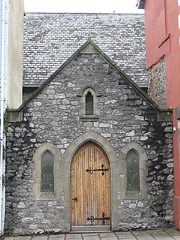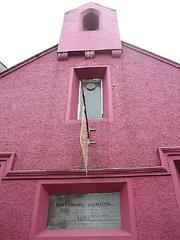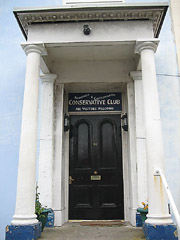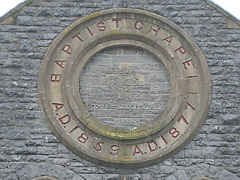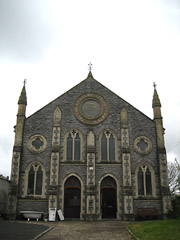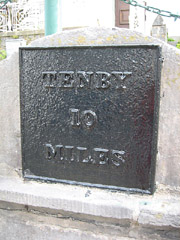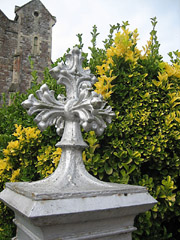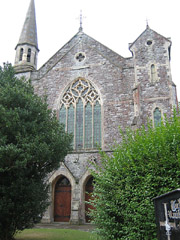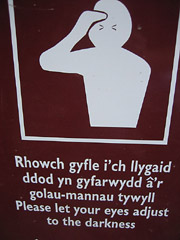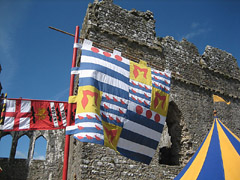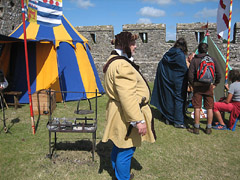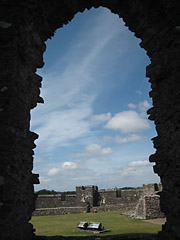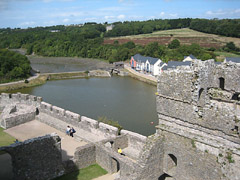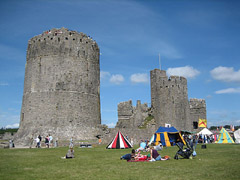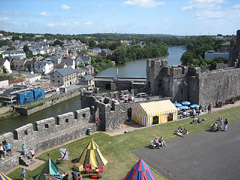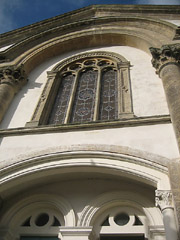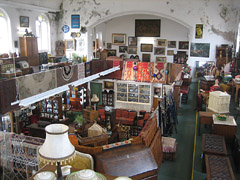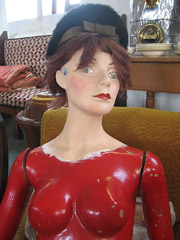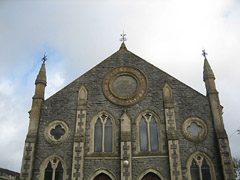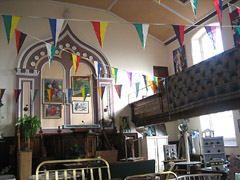Pembroke - From 'A Topographical Dictionary of Wales' (1849)
PEMBROKE, a borough, market-town, and sea-port, and the head of a union, locally in the hundred of Castlemartin, county of Pembroke, in South Wales, 6 miles (S. E. by E.) from Milford, 10 (S. by E.) from Haverfordwest, and 248 (W.) from London; the borough containing 7412 inhabitants, of whom 5441 are in the parish of St. Mary, 1223 in the parish of St. Michael, and 748 in part of St. Nicholas', or Monkton, parish. The name of this place is derived from the words Pen Bro, literally signifying a headland, or promontory, and originally applied to a district nearly corresponding in extent with the present hundred of Castlemartin, stretching out into the sea, and separating Milford Haven, on the north, from the Bristol Channel on the south. On the erection of a castle, and the consequent growth of the town, the name of the district in which they were situated was transferred to them, and subsequently to the whole of the county, of which that town became the capital. The early history of the place is involved in some confusion. It is stated by Giraldus Cambrensis, that Arnulph de Montgomery, in the reign of Henry I., raised a slender fortress of stakes and turf here, which, on his return into England, he placed under the custody of his constable and lieutenant, Giraldus de Windesor. In the Chronicle of Caradoc of Llancarvan, who was contemporary with Giraldus, it is expressly recorded that the castle was attacked in 1092, and again in 1094, by the forces of Cadwgan ab Bleddyn, but that it was so strongly fortified as to baffle every effort of that chieftain to reduce it. The latter of these dates, which is some years prior to the accession of Henry I., contradicts the statement of Giraldus Cambrensis, with respect to the time of the original foundation; and the result of the attacks by so formidable an enemy is at variance with his description of the character of the fortress. Arnulph de Montgomery, on the accession of Henry I., having joined in a confederacy against that sovereign, the castle of Pembroke, together with his other estates, became forfeited to the crown, and the king afterwards conferred the castle, together with the lordship of Carew, and several other manors, on Giraldus de Windesor, Arnulph's lieutenant, who had married N�st, daughter of Rhŷs ab Tewdwr.
According to Caradoc of Llancarvan, Giraldus or Gerald de Windesor rebuilt the castle of Pembroke in the year 1105, on a more advantageous site, called "Congarth Vechan," and removed into it his family and his goods. Soon after this, as we are informed by some authorities, Owain, son of Cadwgan ab Bleddyn, having heard the beauty of N�st extolled at a banquet given by Cadwgan either at the castle of Aberteivy, or at that of Eare Weare in the parish of Amroath, came, under the pretence of relationship, to pay her a visit at this place, and becoming enamoured during the interview, resolved upon carrying her away by force. For this purpose, having obtained the aid of some young men as profligate as himself, he returned in the evening to the castle, which he entered unobserved; then, placing a guard over the chamber of N�st, he set fire to the building, and, in the confusion and alarm that ensued, forcibly conveyed her and her children to his residence in Powys. Other writers, however, are of opinion that the castle of Carew was the scene of this outrage and abduction. The alliance of Gerald with the native princes of the country, by his marriage with N�st, who was some time after restored to him, subsequently excited the jealousy of King Henry, who used every possible means to circumscribe his authority, as far as was consistent with the safety of the English interests in the province.
Gilbert de Clare, surnamed Strongbow, was created Earl of Pembroke by Henry in 1109, and thus became possessed of the royal territories in this quarter, and of the castle of Pembroke. In 1138, the earldom was erected into a county palatine, with the privilege of jura regalia; and under the authority of its earl, a session and a monthly county court were held within the castle. In the latter all pleas of the crown were determined, fines levied, and recoveries passed; the writs were issued in the name of the earl, who held also at this place his courts of chancery and exchequer. Strongbow enlarged the castle, which he strengthened with additional fortifications, and made in every respect a residence suitable to the dignity of the elevated rank he held. He also incorporated the inhabitants of the town which had arisen under the protection of the castle, and surrounded it with a lofty embattled wall, defended by numerous bastions, and entered by three principal gates and a postern. Under the protection and influence of its earls, Pembroke became a place of great importance; and in the year 1172, Henry II. kept the festival of Easter in the castle. About three centuries afterwards, another event of some interest occurred: Jasper Tudor, Earl of Pembroke, after the defeat of the Lancastrians at the battle of Barnet, retired into the castle, in which the young Earl of Richmond and his mother were then residing; and here he was soon besieged by Morgan ab Thomas, brother of the celebrated Rhŷs ab Thomas, a zealous partisan of the house of York, to whom he must have surrendered the fortress, had not David, another brother, who had embraced the opposite interest, come promptly to his assistance, and conveyed him, together with the Countess of Richmond and her son, to Tenby, where they embarked for France. The suppression of the palatine jurisdiction, in the reign of Henry VIII., deprived Pembroke of its dignity as the metropolis of a regality.
During the civil war of the seventeenth century, the strength of Pembroke rendered it the scene of some important transactions. The castle, at the commencement of the war, was the only fortress possessed by the parliament in this part of the principality, and was placed under the command of Colonel Rowland Laugharne. In 1643, Admiral Swanley arrived with the parliamentarian fleet in Milford Haven, and reinforced the garrison with 200 mariners and several small pieces of cannon, with the aid of which the governor succeeded in reducing most of the neighbouring fortresses, which were all garrisoned for the king. In 1647, Colonel Laugharne, and likewise Colonels Powell and Poyer, abandoning the interest of the parliament, and embracing that of the opposite party, made Pembroke their head-quarters, and the rallying point for the army which they raised on the king's behalf; and in 1648, after their defeat in the disastrous battle of St. Fagan's, in Glamorganshire, they retired hither with the remnant of their forces, closely followed by an army led by Cromwell in person, who immediately commenced the siege of the town, taking post at Welsdon, a village about two miles and a half from it. The siege was conducted with the greatest vigour, and sustained with obstinate valour by the garrison, who were resolved to hold out to the last extremity; but Cromwell having found means to destroy their mills, and their supply of water being also cut off by the destruction of a staircase leading into a cavern under one of the towers, in which was the chief reservoir, there remained only the alternative of a lingering death or immediate submission. Under these circumstances the garrison capitulated, on condition that their chief leaders should throw themselves on the mercy of the parliament; that several of the inferior officers should leave the kingdom, not to return within two years; that all arms and ammunition should be given up, and that the town should be spared from plunder. Laugharne, Powell, and Poyer were afterwards tried by a courtmartial, and being found guilty of treason, were condemned to be shot; but the authorities were induced to spare two of them, and ordered that they should draw lots for the favour. Accordingly three papers were folded up, on two of which was written "Life given by God," the third being left blank: the latter was drawn by Colonel Poyer, who was shot in Covent Garden, on the 25th of April, 1649. That the surrender of the garrison was justly attributed in a great measure to the failure of their supply of water by the accident above noticed, has been confirmed by a discovery of the cavern, in which a copious spring of water was found, with the shattered remains of a staircase leading to it from the tower, the bones of a man, and several cannon balls.
The importance of Pembroke subsequently to the abolition of the palatinate depending principally upon its castle, which, after the events of the civil war, was never re-fortified, it now experienced a further decline, owing to its remote situation and want of commerce; and though it nominally retained its dignity as the capital of the county, it dwindled into comparative insignificance, as all the substantial benefits arising from that distinction were transferred to Haverfordwest, which, from its more central situation, was found better adapted for the transaction of the business of the shire. The removal of the government dockyard from Milford to the place in 1814, however, materially contributed to revive its prosperity. Since that period it has been gradually increasing in extent and population, and from the many local advantages which it possesses for an establishment of this nature, there is every prospect of its becoming in due time one of the most considerable naval arsenals in the kingdom.
The town is beautifully situated on an elevated ridge projecting into the head of the Pennar Mouth Pill, forming the largest southern creek of Milford Haven. It divides the creek into two branches, by which, at high water, it is nearly insulated, and over each of which is a neat bridge of stone. It consists principally of one long street, irregularly built, connected on the west with the ancient village of Monkton, which forms a suburb to the town, and on the north with a new street leading to PembrokeDock, a flourishing and populous place, about two miles to the north-west, within the parish of St. Mary, forming a distinct town, which has arisen since the removal of the dockyard thither from Milford. The houses are built on both sides of the ridge, of which the western extremity is crowned with the magnificent ruins of the castle; and on each side are gardens sloping down from the houses to the water's edge. The embattled walls with which ancient Pembroke was surrounded are still tolerably perfect on the north side, and the town, rising above the waters of the broad inlet, amidst some of the richest scenery in this part of the principality, has an air, in some aspects, of venerable grandeur, and in others of picturesque beauty. The streets are partially paved and lighted, and the inhabitants are amply supplied with excellent water from seven public conduits in different parts of the town, to which it is conveyed from a distance of half a mile, by means of pipes laid down at the expense of the corporation. Exclusively of Pembroke-Dock and the village of Monkton, the town contains about 2000 inhabitants, partly included in St. Mary's parish, and partly in St. Michael's.
There are no particular manufactures carried on at Pembroke, the inhabitants consisting of persons of small independent fortune, shop-keepers, and a few whose business is at the dock; but it serves in a great measure as a dep�t for the neighbouring districts. Stone-coal is brought from a distance of about six miles to the east of it, and bituminous coal from Swansea, Llanelly, Newport, and other towns on the southern coast. When colonial produce was not permitted to be imported into Ireland direct, it was lodged in warehouses appropriated to the purpose at Pembroke ferry, in the parish of St. Mary; but that place is at present of no commercial importance. The market, which is abundantly supplied with provisions of every kind, is on Saturday. There are fairs held annually on April 12th, Trinity-Monday, July 10th, October 10th, and November 30th; and in the suburb of Monkton, on May 4th and September 25th.
The borough, in addition to the towns of Pembroke and Pembroke-Dock, comprises a considerable agricultural district. The parish of St. Mary is surrounded by the parishes of St. Michael, Cosheston, and Monkton, and is computed to contain about 2000 acres, of which nearly 1600 are meadow and pasture, and 400 arable: the soil is of a reddish colour, and indifferent quality, except a line of limestone which passes through it; and there is little timber of any kind. St. Michael's is bounded by the parishes of St. Mary, Nash, Cosheston, Lamphey, and St. Petrox, and is calculated to comprise about 1800 acres, of which nearly 1400 are meadow and pasture, and 400 arable: there is little timber, and the soil is of much the same character as that of St. Mary's, but rather better; a line of limestone, also, runs from east to west through the parish, and there are a few small quarries. The parish of St. Nicholas', or Monkton, comprising a village or suburb within the limits of the borough, and a rural district in the hundred of Castlemartin, is noticed under its own head.
Pembroke-Dock, sometimes called Pater, or Paterchurch, is situated on the southern shore of Milford Haven, about two miles from the old town. It consists of several streets of neat and well-built houses, and is partially paved, but not lighted; there are numerous good shops for the supply of the population, several of which are branches from the larger establishments in the town of Pembroke. A handsome inclosed market-place was erected some time ago. The dock-yard forms an area of eighty acres, inclosed within a lofty wall of stone, and comprises a neat range of buildings for the transaction of the public business, houses for the principal officers of the establishment, and a fort for the defence of the place, mounting twenty-three long twenty-four pounders. There are thirteen slips for ship-building, some of them adapted for building first-rates; also a dock, which will contain the largest class ships, having an average depth of twenty-three feet. Among the other branches of the establishment are, a smithery; an extensive pond for the immersion of elm timber; and a steam-engine for pumping out the dock, which also drives a saw-mill, working two frames and a circular saw. Some of the finest ships in the navy have been launched here. Large barracks have recently been built under the superintendence of Capt. Farris, R.E.; they form an imperfect octagon, including an area of more than 6000 square yards, and are strongly fortified with bastions, a wide and deep ditch, and loops for small arms. Besides the government establishment there is a small private dock; and the Irish packet establishment has been some years removed from Milford to this place, with a view to which alteration a very fine jetty was constructed at Hobbs' Point, a few hundred yards to the east of the dockyard; new roads, also, were formed, connecting Hobbs' Point with the main road from Carmarthen, in a new line avoiding both Narberth and Haverfordwest, by which route the mail saves a distance of several miles. In connexion with the packet-station, a large hotel was built by government. The great South Wales railway will have a branch of nineteen miles and a half to Pembroke-Dock, the formation of which will tend greatly to the improvement of the whole district: some particulars of the line are given under the heads of Pembrokeshire and Carmarthenshire, and a fuller account under that of Glamorganshire. Within the last few years, the fortifications connected with the dockyard have been materially strengthened. About a mile to the east of the dockyard is Pembroke ferry, belonging to the crown, and held by Sir John Owen, Bart., who underlets it at an annual rent of �105: it forms the shortest and most usual line of communication between Haverfordwest and Pembroke, the distance between which places by the ferry is only ten miles, but by Narberth twenty-five; the fares are, a halfpenny for a foot-passenger, a penny for a man and horse, and a shilling per wheel for carriages. Steam-communication is maintained between Pembroke-Dock and Haverfordwest, Milford, Tenby, and Bristol. The entrance from Milford Haven to the creek at the head of which the town of Pembroke is situated, at low water is little more than a hundred yards wide, and from nine to twelve feet deep; but proceeding upwards it immediately expands into a wide oozy reach, called Crow Pool, containing an abundance of excellent oysters.
The inhabitants of Pembroke received their first charter of INCORPORATION from Gilbert Strongbow, Earl of Pembroke, in the time of Stephen. In 1168, Henry II. confirmed to them all the privileges which they had previously enjoyed; also granting that they should not answer in any plea out of their own town, unless the same should concern the crown; that they should be exempt from toll in Bristol, Gloucester, Winchester, Devonshire, Cornwall, Rochelle, and Normandy; and that they should have an eight days' annual fair, beginning at the feast of St. Peter and St. Paul. By a charter of King John's the freedom from toll appears to have been extended, and a second fair of two days granted, commencing on the eve of John the Baptist. All former charters were confirmed by Richard III. in the 2nd year of his reign, by Henry VIII. in the 9th year, by Edward VI. in the 1st year, and lastly by James I. in the 5th, of his reign. In the grant by Richard it was declared, that "the town shall now become a corporate body, instead of being, as hitherto, incorporate; and shall consist of a mayor, two bailiffs, and the burgesses of the said place."
Until the Municipal Corporations' Act was passed, the title of the corporation was "the Mayor, Bailiffs, and Burgesses of the town and borough of Pembroke," and the government was vested in a mayor, an indefinite number of common-councilmen, a town-clerk, two bailiffs, two serjeants-at-mace, and an unlimited number of freemen or burgesses; the mayor and common-council forming the controlling body. The mayor, who was a justice of the peace concurrently with the county magistrates, also coroner, and a judge of the "Fortnight Court," was elected in July, by the burgesses, out of three members of the commoncouncil proposed in council as candidates. The councilmen were appointed by a majority of the council and the mayor, and those of them who had served the office of mayor were styled aldermen: one of the bailiffs was chosen by the mayor, the other by the council; and the serjeants-at-mace were elected in a similar manner. The corporation is now styled the "Mayor, Aldermen, and Burgesses," and consists of a mayor, six aldermen, and eighteen councillors, forming the council of the borough, which is divided into two wards, and of which the municipal and parliamentary boundaries are the same. The council elect the mayor annually on November 9th, out of the aldermen or councillors; and the aldermen triennially from among the councillors, or persons qualified as such, one-half going out of office every three years, but being re-eligible: the councillors are chosen by and out of the enrolled burgesses, on November 1st, one-third going out of office every year. Aldermen and councillors must each have a property qualification amounting to �500, or be rated at �15 annual value. The burgesses consist of the occupiers of houses and shops who have been rated for three years to the relief of the poor. Two assessors for each ward, and two auditors, are elected annually on March 1st by and out of the burgesses; and the council appoint a town-clerk, treasurer, and other officers on November 9th. The total number of borough magistrates is seven.
Pembroke sends a member to parliament with the contributory boroughs of Tenby, Wiston, and Milford, which last was added by the act passed in 1832, for "Amending the Representation." The right of election was formerly vested in the mayor, bailiffs, and burgesses of the borough, but is now, by the act, confined to the old resident freemen, and extended to every male person of full age occupying, either as owner, or as tenant under the same landlord, a house or other premises of the annual value of not less than ten pounds, provided he be capable of registering as the act directs. The number of tenements of this value, within the limits of the borough, which are minutely detailed in the Appendix, is 270, including those in the village of Monkton, which is included within the borough. The mayor is the returning officer. The revenue of the corporation amounts to about �100, arising out of the tolls of the markets and fairs. This town is a polling-place in the election of a knight for the shire. The powers of the county debt-court of Pembroke, established in 1847, extend over the registration-district of Pembroke. There is a town-hall, a plain modern building in the centre of the south side of the principal street, and underneath it is a commodious area for the corn-market.
The LIVINGS of the three parishes of St. Mary, St. Michael, and St. Nicholas, are consolidated into one discharged vicarage, rated in the king's books at �9, viz., �4 for St. Michael's, and �5 for the living of Monkton or St. Nicholas, St. Mary's not being in charge; patron and impropriator, Sir John Owen, Bart. The tithes of St. Mary's parish have been commuted for �187. 10. payable to the impropriator, and �162. 10. to the vicar; the tithes of St. Michael's for �162. 10. payable to the impropriator, and a similar sum to the vicar; and the tithes of Monkton for �300 to the impropriator, and �175 to the vicar. A glebe-house is attached to the benefice. The church dedicated to St. Mary is an ancient and venerable structure, in the Norman style, situated near the centre of the town, and composed of a nave, chancel, and north aisle, with a small chapel on the southern side: in the north aisle and in the chancel are doorways, now closed up, which communicated with additional buildings no longer standing. That dedicated to St. Michael has been rebuilt almost from the ground, in the later English style of architecture, the expense being defrayed by a parochial rate; it will accommodate about 1000 persons, and the number of free sittings is 400. These churches had anciently chapels of ease, situated a little distance without the walls of the town; and on the summit of an eminence, about three quarters of a mile to the south, still stands an ancient ecclesiastical edifice, dedicated to St. Daniel, with a lofty spire rising from a low tower; now private property. The incumbency of St. John the Evangelist, Pembroke-Dock, was formed in 1844, under the act 6th and 7th Victoria, cap. 37, and is in the gift of the Crown and the Bishop of St. David's, alternately: the church was begun in 1846, completed in 1848, and is in the pointed style, with a tower. The net income of this living is �150, and the district or ecclesiastical parish annexed to it comprises about 4000 persons. The church of St. Nicholas is described under the head of that parish. There are places of worship for Baptists, Independents, and Calvinistic and Wesleyan Methodists. The different parishes of Pembroke, though ecclesiastically united, continue separate for all civil purposes.
A grammar school founded here in 1690 has an endowment of �11. 3. 4. per annum, arising from various bequests of rent-charges, by Sir Hugh Owen, Bart., Morgan Davies, and Griffith Dawes, and from a sum in lieu of the corn-toll granted to the master by the corporation at an early period. No school is now kept, as the shire-hall, in which it was held, was pulled down in 1820; but a master is still appointed by the mayor and council. There are a National school in the parish of St. Michael, and National schools and a British school at Pembroke-Dock; also a number of Sunday schools in the borough. Dr. I. Jones, of Carmarthen, in 1698, bequeathed his estates, real and personal, to be appropriated to the apprenticing of children and the relief of the poor in Lawrenny, St. David's, Cosheston, and Lampeter-Velvrey; with a discretionary power to his brother, the Rev. William Jones, to add such parishes as he should think proper to the four named by the testator. Mr. W. Jones accordingly, by deed, in 1703, vested in three trustees the several sums of �300, �100, and �44, to be laid out in the purchase of land, which was effected shortly after in the parishes of Llandysilio-Gogo and Llanllwchaiarn, and the rents to be appropriated to the apprenticing of children, and the relief of the poor, of Pembroke; to which purposes the income, now �143. 13., is applied. About �18 are annually expended in apprenticing six children, and the residue, after the payment of some incidental charges, is distributed among the poor. Matthew Warren bequeathed a rent-charge of �2. 12., Dr. Powell one of 10s., and George Evans another of 14s., for bread to twelve widows; and Richard Howell bequeathed �100; Margaret Mears, �30, of which �10 have been lost; Sir Hugh Owen Bart., �20; and Sir Martin Beckman, �5, for the poor. There are some other small charitable donations and bequests, and a few have been lost.
The poor-law union of which this town is the head, was formed January 6th, 1837, and comprises the following twenty-nine parishes and townships; namely, St. Mary, and St. Michael (Pembroke), St. Nicholas or Monkton, Angle, Bosherston, Burton, Carew, Castlemartin, Cosheston, St. Florence, Gumfreston, Hodgeston, Lamphey, Lawrenny, Llanstadwell, Manorbeer, Nash, Penalley, St. Petrox, Pwllcrochon, Redbarth, Rh�scrowther, Rh�smarket, StackpoolElidur, St. Mary Tenby (In Liberty and Out Liberty), St. Twinnel's, Upton, and Warren. It is under the superintendence of thirty-five guardians, and contains a population of 19,671.
The majestic and venerable remains of the ancient CASTLE occupy the western extremity of the elevated ridge on which the town is built, and are justly regarded as among the most picturesque and magnificent ruins in the country. The entire fortress was surrounded by a lofty embattled wall, protected by numerous bastions, and having only one entrance from the land, through a grand gateway defended by two circular towers of prodigious strength, and a barbican. On this side it had likewise a dry moat, and the inclosed area was divided into an inner and an outer ward, the former of which comprised the state apartments, and the latter the inferior buildings and the offices for the use of the garrison. The principal remains consist of this grand entrance, the state apartments occupying the northern side, and the keep, which last is in the inner court, a massive and lofty round tower, 75 feet high, 163 feet in circumference at the base, and gradually diminishing in diameter towards the top, which is covered with a vaulted roof. This tower is divided into five stages; the walls are seventeen feet in thickness at the base, and fourteen feet thick at the summit. From the summit is obtained a most extensive and delightful prospect, comprehending the greater part of Pembrokeshire, from the Percelly mountains, on the north, to the sea, and from the Carmarthenshire hills, on the east, to St. George's Channel; presenting a fine open champaign country, intersected by the numerous estuaries that unite to form the noble Haven of Milford, and diversified and enlivened with cheerful villages, and gentlemen's seats: among these latter, Cresselly, Clareston, Orielton, and others, whose grounds are richly wooded, form a striking and beautiful contrast to the general appearance of the country, which is elsewhere almost destitute of timber. In the inner court, besides the keep, is a suite of apartments, apparently of later date than the rest of the castle, extending over the cavern called the Wogan, or Hogan, by corruption of the Welsh word Ogov, signifying "a cave." This subterraneous chamber is seventy-five feet in length and fifty-nine feet wide, and communicates with the upper part of the castle by a staircase, and with the harbour below by a sally-port. The rock on which the castle is built is forty feet high, and is almost insulated by the two branches of the estuary into which it projects, and which is navigable to the town; under the southeastern bastion is a natural opening in it, of unknown extent. The great solidity of the walls, and its commanding situation, must have rendered this fortress all but impregnable against any hostile attempt. Its ponderous towers, with the northern suite of state apartments rising above the embattled walls, and part of the platform and parapet, which are still remaining, give its present ruins an air of venerable grandeur; and the ivy and other parasitical plants with which the ruins are overspread contribute to heighten the picturesque beauty of their appearance. Leland says, he was shown an apartment in one of the gateway towers, in which, he was informed, Henry VII. was born; but other writers refer that circumstance to a room in the inner court of the castle. Pembroke Castle is now the property of the crown, and is held under lease granted in the reign of James II. The town gives the title of earl to the noble family of Herbert. |


